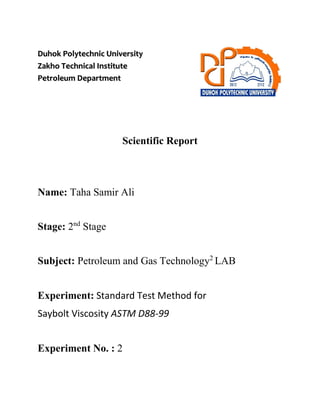
Saybolt viscosity
- 1. Duhok Polytechnic University Zakho Technical Institute Petroleum Department Scientific Report Name: Taha Samir Ali Stage: 2nd Stage Subject: Petroleum and Gas Technology2 LAB Experiment: Standard Test Method for Saybolt Viscosity ASTM D88-99 Experiment No. : 2
- 2. Objective: To determine saybolt viscosity of petroleum products at specified temperature (21-99) °C. Introduction: This test method covers the empirical procedures for Determining the Saybolt Universal or Saybolt Furol viscosities Of petroleum products at specified temperatures between 21 and 99°C (70 and 210°F). It is recommended that viscosity indexes be calculated from kinematic rather than Saybolt viscosities. There are two types: 1-saybolt universal viscosity: It is the corrected efflux time in seconds of 60 mL of sample flowing through a calibrated universal orifice under specified condition. The viscosity value is reported in Saybolt universal seconds abbreviated SUS, at a specified temperature. It is determine using an orifice of (1.76 ±0.015) mm in diameter used for lubricants and distillates with efflux time greater than 32 sec. and less than 1000 sec.
- 3. 2-Saybolt furol viscosity: It is s the corrected efflux time in seconds of 60 mL of sample flowing through a calibrated orifice under gravity at specified temperature. The viscosity value is reported in Saybolt Furol seconds, abbreviated SFS, at a specified temperature. This is determined using an orifice of (3.15 ±0.02) mm in diameter used when "SUS" value is greater than 1000 sec. The viscosity value is reported in-Saybolt Furol seconds, abbreviated SFS, at a specified temperature. The "SFS" is approximately one tenth the "SUS". Furol: refers to "Fuel and road oils." Apparatus: 1-saybolt viscosity test assembly (water or oil bath, electrical heater, sample container with orifice and stopper, mixer). 2-Receiving flask. 3-Thermometer. 4-stop watch.
- 4. Procedures: 1. Clean viscometer and receiving flask with appropriate solvent. 2. Place the receiving flask below the bottom of the viscometer. 3. Fill the bath to with water for test temperature less than 98 °C and oil for higher test temperature. Place the sample in the viscometer container and insert a cork stopper at the bottom of the viscometer. 5. Control bath temperature. 6. Snap the cork and start the timer. 7. Stop the timer the instant the bottom of the oil meniscus reaches graduation mark (60 ml). 8. Record the efflux timer in seconds to the nearest 0.1 sec. This will be the viscosity. Results & Calculation: 1-Report the time in the seconds to in nearest 0.1 sec. 2-To draw the relationship between viscosity and temperature, arranged a table contains (temperature and efflux) as follows:-
- 5. Temperature °C Efflux time (viscosity) in sec 1- 30°C 2- 35°C 3- 40°C 1- 503 sec 2- 409 sec 3- 336 sec 0 100 200 300 400 500 600 1 2 3 4 Relationship between Viscosity & Temperatue
- 6. The viscosity in centistokes can be calculated using this equation: cSt=0.226 S-195/S for S 32-100 cSt=0.22*S-135/S for S>100 Where:cSt= viscosity in centistokes, S=viscosity in SUS Calculation Kinematic Viscosity: 1. cst=0.22×S-135/S =0.22×503-135/503 =110.66 - 0.2683 =110.3917 cSt 2. cst=0.22×S-135/S =0.22×409-135/409 =89.98 – 0.3300 =89.65 cSt 3. cst=0.22×S-135/S =0.22×336-135/336 =73.93 – 0.4017 =73.52 cSt
- 7. Discussion: 1-what is the effect of temperature on viscosity? - When a liquid heats up, its molecules become excited and begin to move. The energy of this movement is enough to overcome the forces that bind the molecules together, for example, when honey is cold it has a high viscosity and can be difficult to pour. When heated in microwaves, the viscosity decrease and the honey flows more freely. 2-what is used on the bath media of viscosity test? Why? -In this method we use the Oil bath, because oil is for higher test temperature or sometimes using water for less than 98 °C. 3-set another method to determine the viscosity? - Calculating the dynamic viscosity using kinematic viscosity (Standard Test Method for Viscosity of Transparent Liquids) by using Viscometer. 4-what is the viscosity index of lube oil? - It is the rate of change of viscosity between 2 temperatures. The lower the Viscosity Index, the more the drop in viscosity as the oil warms up. The higher the VI value, the less the drop in viscosity as the oil warms up. Generally, the less it changes, across a range of temperatures, the better.